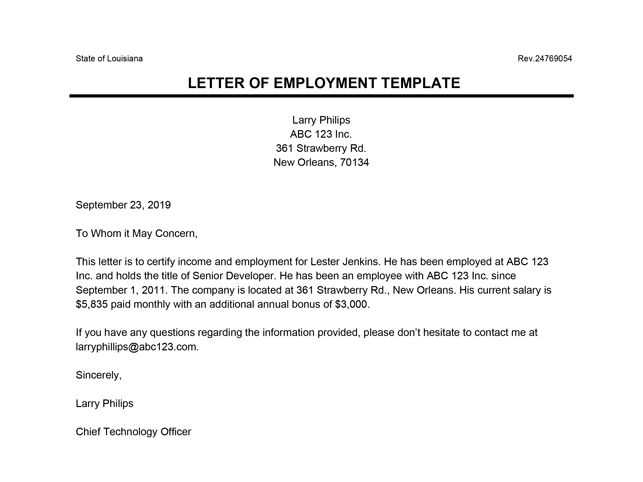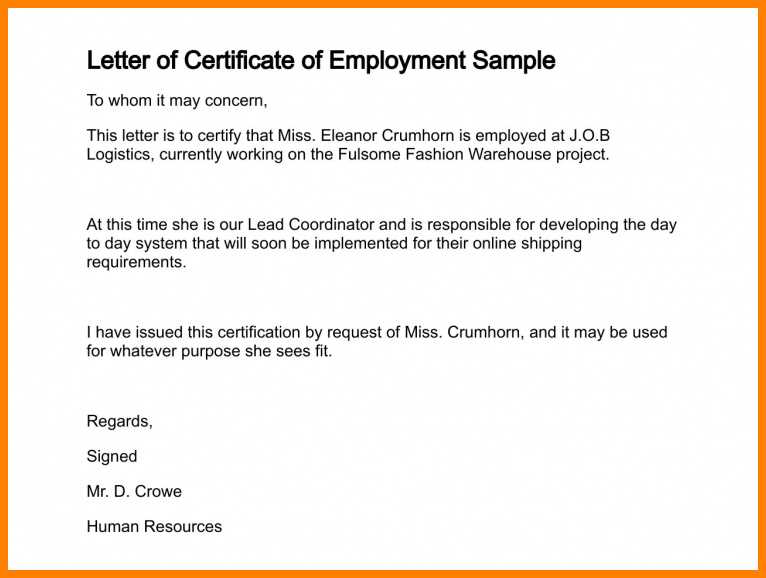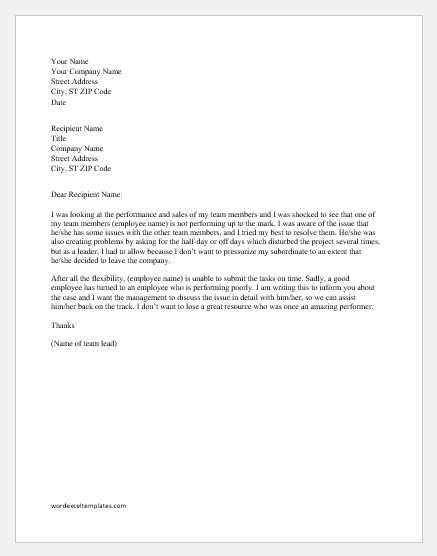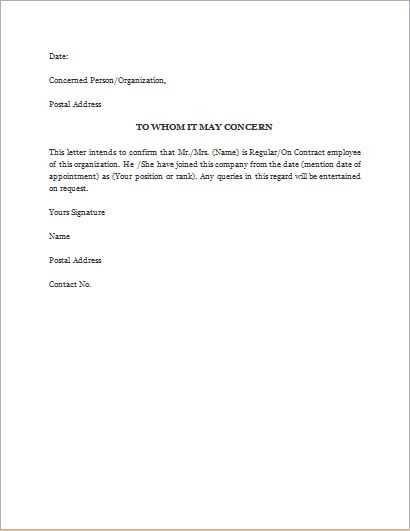Letter of Concern Template for Employees

In a professional environment, addressing issues directly and constructively is key to maintaining a productive atmosphere. When challenges arise between management and staff, it’s crucial to approach the situation with clarity and respect. A formal written document can serve as a means to express concerns and expectations without escalating tension.
By using a well-structured message, leaders can convey their points efficiently, ensuring that any problems are addressed and resolved in a timely manner. This type of communication not only helps in correcting behaviors but also fosters mutual understanding between parties involved.
Creating a well-crafted document ensures that all necessary details are included, and it provides a record for future reference. This allows both sides to have a clear understanding of what was discussed and agreed upon, promoting transparency in the workplace.
Why Formal Communication Matters
In any organization, effective communication is essential for resolving misunderstandings, aligning expectations, and addressing issues. Written messages serve as a formal way to ensure that important information is conveyed clearly and professionally. These documents help to formalize discussions and act as a reference point for both parties involved.
Key Reasons for Formal Written Communication

- Provides a clear record of the conversation.
- Ensures both sides understand the issues and expectations.
- Helps maintain professionalism and respect in sensitive situations.
- Offers a structured approach to resolving conflicts or misunderstandings.
The Importance of Clarity and Tone
When drafting a formal written communication, it’s crucial to maintain a neutral and respectful tone. The message should be clear, concise, and focused on the facts. By doing so, misunderstandings can be minimized, and the recipient is more likely to respond positively.
Key Elements in a Concern Letter

When addressing issues within a professional setting, it’s crucial to include specific components to ensure the message is clear and effective. A well-structured document serves as a tool to express the necessary information and outline expectations in a way that is both respectful and constructive.
Introduction and Purpose
Start by introducing the purpose of the communication. This section sets the tone, explaining the reason for reaching out and identifying the situation or behavior that needs to be addressed. It should be direct but tactful, ensuring that the recipient understands the importance of the matter.
Clear Description of the Issue
Next, provide a detailed but objective description of the issue. Be specific about what has occurred and include relevant dates or examples if needed. This part of the message ensures that the recipient understands the specific behavior or performance that is being addressed without ambiguity.
Expected Outcomes or Solutions
Outline the desired outcome or the changes you expect to see. Providing clear, actionable expectations can help guide the recipient toward resolving the issue. It’s important to focus on solutions rather than just the problem, fostering a sense of direction.
Closing Remarks
Finish with a closing statement that reinforces the importance of addressing the matter promptly. Offer support or assistance in resolving the situation, emphasizing the collaborative nature of the process. This leaves the door open for further discussion or clarification if needed.
Approaching Sensitive Issues Professionally
When challenges arise in the workplace, addressing them with care and professionalism is essential for maintaining a positive environment. It’s important to approach such matters in a way that is respectful, clear, and solution-oriented. Fostering open communication while maintaining authority helps to resolve issues without escalating tensions.
Start by gathering all the facts before addressing the situation. Make sure that your message is based on objective observations, and be mindful of how it may be received. Aim to communicate in a way that focuses on improvement, not just the problem at hand.
Offering solutions or suggestions for improvement shows that you are invested in helping the individual overcome any obstacles they may face. Creating a collaborative atmosphere where both parties can work together fosters a sense of trust and motivation.
Step-by-Step Process for Writing a Letter
When creating a formal written communication, it’s important to follow a clear structure to ensure the message is both professional and effective. The process involves several key steps that help you stay focused on the issue at hand while maintaining a respectful tone. By adhering to these steps, you can craft a message that addresses the situation directly and constructively.
- Start with a Formal Greeting
Begin by addressing the recipient with a polite and respectful greeting. This sets the tone for the message and establishes a professional atmosphere. - State the Purpose Clearly
In the opening lines, explain the purpose of the communication. Be concise but specific, ensuring the recipient understands why you are reaching out. - Describe the Situation or Issue
Provide a clear and objective account of the issue. Include relevant facts or examples to ensure the situation is fully understood. Stick to the specifics without making it personal. - Propose Solutions or Expectations
Outline the expected outcome or solutions to resolve the situation. Be clear about what changes need to be made and the timeline for improvement. - Close with a Professional Tone
End the message with a polite closing, offering assistance or support if needed. Reiterate your willingness to work together to resolve the issue.
By following these steps, you can ensure that your communication is clear, respectful, and productive, helping to address workplace matters efficiently and professionally.
Common Pitfalls and How to Avoid Them

When writing formal messages to address workplace issues, several mistakes can affect the clarity and effectiveness of the communication. Being aware of these pitfalls can help ensure your message is professional, clear, and constructive. Below are some of the most common mistakes and tips on how to avoid them.
| Common Mistake | How to Avoid It |
|---|---|
| Using negative or accusatory language | Keep the tone neutral and avoid blame. Focus on the issue rather than attacking the person. |
| Being too vague | Provide specific examples and details. Ensure the recipient understands the exact situation being addressed. |
| Not offering a clear resolution | Always suggest a course of action or expectations for improvement to guide the recipient towards a solution. |
| Failing to maintain professionalism | Use formal language and structure. Keep the communication respectful, even when addressing difficult issues. |
By avoiding these common mistakes, you can ensure that your written communication remains constructive and effective, promoting a positive and professional outcome.
Best Methods for Sending a Letter

Choosing the right method to send a formal communication is crucial for ensuring that the message is received promptly and with the proper attention. Different methods can have varying impacts depending on the urgency of the situation and the nature of the message. Selecting an appropriate delivery method helps to maintain professionalism while ensuring effective communication.
Direct Email
For quick and efficient delivery, email is often the preferred method. It allows for immediate receipt and provides a record of the communication. Ensure the subject line is clear and specific, and attach any necessary documents for reference.
Printed Copy
In some cases, delivering a physical copy of the communication may be necessary, especially for more formal or serious matters. Ensure the document is printed on official company letterhead and is delivered in a professional manner, either through hand delivery or postal services.
Follow-up Communication
Regardless of the initial method of delivery, it’s important to follow up to confirm receipt and ensure the recipient has understood the message. A brief phone call or follow-up email can serve as a helpful reminder or clarification if necessary.